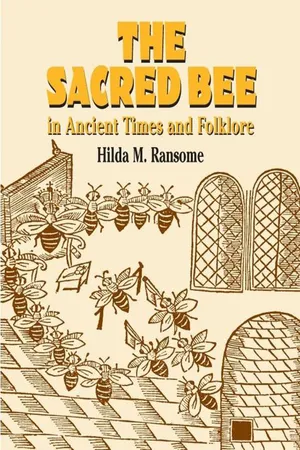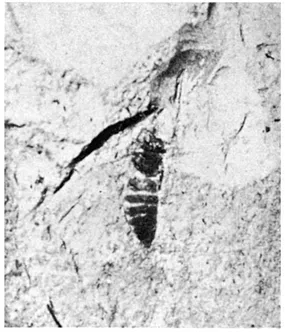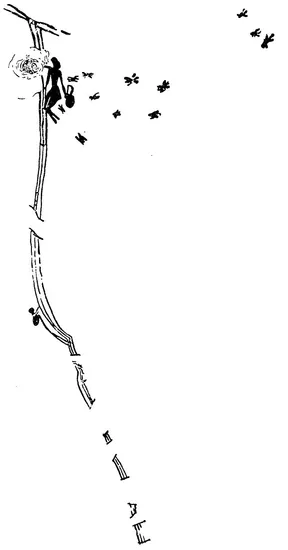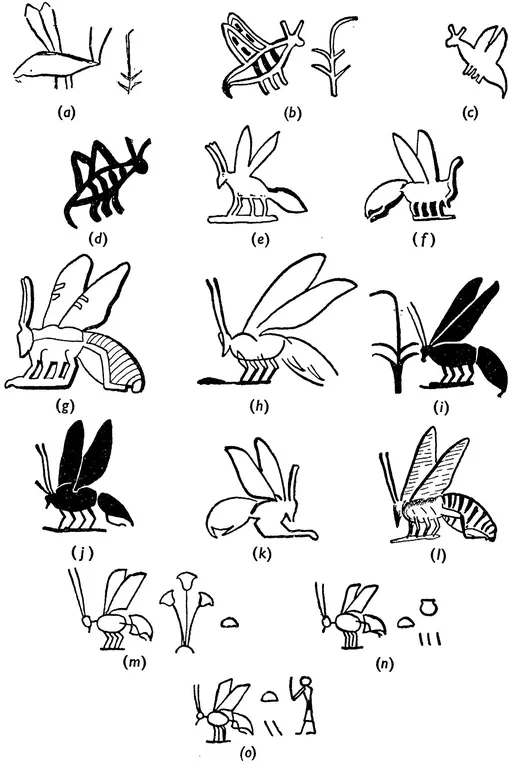
- 336 pages
- English
- ePUB (mobile friendly)
- Available on iOS & Android
eBook - ePub
The Sacred Bee in Ancient Times and Folklore
About this book
No creature has provided man with so much wholesome food as the honey bee. Equally impressive is the number of beliefs and superstitions the industrious insect has inspired. Its honey, which was known to the ancient Greeks as the “food of the Gods,” played an important role in early religious rites and was also mentioned in the folklore of many peoples. Hilda Ransome's well-documented and copiously illustrated study of bees focuses on this valuable byproduct of nature and its creator — the "sacred" bee.
Chapters cover the folklore of bees and bee culture — from Egyptian, Babylonian, Chinese, Hittite, and other ancient sources as well as practices in modern England, France, and Central Europe. Thirty-five plates of rare black-and-white illustrations depict bees, hives, and beekeepers as they appear in ancient paintings and sculpture, on coins, jewelry, and Mayan glyphs; and carved into African tree trunks. Folk stories from Finland and the bee in America are also described.
Hailed by The New York Times as possessing an "oddity, beauty, and broad scholarly interest," this unusual book will attract a wide audience — nature lovers and folklore enthusiasts included.
Chapters cover the folklore of bees and bee culture — from Egyptian, Babylonian, Chinese, Hittite, and other ancient sources as well as practices in modern England, France, and Central Europe. Thirty-five plates of rare black-and-white illustrations depict bees, hives, and beekeepers as they appear in ancient paintings and sculpture, on coins, jewelry, and Mayan glyphs; and carved into African tree trunks. Folk stories from Finland and the bee in America are also described.
Hailed by The New York Times as possessing an "oddity, beauty, and broad scholarly interest," this unusual book will attract a wide audience — nature lovers and folklore enthusiasts included.
Frequently asked questions
Yes, you can cancel anytime from the Subscription tab in your account settings on the Perlego website. Your subscription will stay active until the end of your current billing period. Learn how to cancel your subscription.
At the moment all of our mobile-responsive ePub books are available to download via the app. Most of our PDFs are also available to download and we're working on making the final remaining ones downloadable now. Learn more here.
Perlego offers two plans: Essential and Complete
- Essential is ideal for learners and professionals who enjoy exploring a wide range of subjects. Access the Essential Library with 800,000+ trusted titles and best-sellers across business, personal growth, and the humanities. Includes unlimited reading time and Standard Read Aloud voice.
- Complete: Perfect for advanced learners and researchers needing full, unrestricted access. Unlock 1.4M+ books across hundreds of subjects, including academic and specialized titles. The Complete Plan also includes advanced features like Premium Read Aloud and Research Assistant.
We are an online textbook subscription service, where you can get access to an entire online library for less than the price of a single book per month. With over 1 million books across 1000+ topics, we’ve got you covered! Learn more here.
Look out for the read-aloud symbol on your next book to see if you can listen to it. The read-aloud tool reads text aloud for you, highlighting the text as it is being read. You can pause it, speed it up and slow it down. Learn more here.
Yes! You can use the Perlego app on both iOS or Android devices to read anytime, anywhere — even offline. Perfect for commutes or when you’re on the go.
Please note we cannot support devices running on iOS 13 and Android 7 or earlier. Learn more about using the app.
Please note we cannot support devices running on iOS 13 and Android 7 or earlier. Learn more about using the app.
Yes, you can access The Sacred Bee in Ancient Times and Folklore by Hilda M. Ransome in PDF and/or ePUB format, as well as other popular books in History & World History. We have over one million books available in our catalogue for you to explore.
Information
CHAPTER I
EARLY TIMES
Honey used by primitive man—Bee regarded with reverence and awe—Fossil forms—‟Apis adamitica”—Rock painting of man and bees’ nest at Bicorp, Spain
OF bees especially the proverb holds good, “Truth is stranger than fiction.” Among all the members of the insect world bees and ants have aroused greater interest than any others, but it is the bees who have been of paramount use to man. As we look back upon their history we become more and more convinced that it is impossible to over-estimate their value to man in the past.
What veneration and yet what fear these tiny creatures excited in man! They exercise a fascination even on those who fear their sting, and all who tend them have quite a peculiar love and regard for them which they do not feel for other animals, and which is a bond of union between all beekeepers; they feel that they belong to a fraternity which reckons Vergil among their number. From the dawn of human society the nature and origin of the bee have awakened the curiosity and interest of man. For thousands of years honey was the only sweetening material known, and it is quite natural that in ancient times the little busy creature who produced this sweet food should have been regarded with reverence and awe.
Man very early discovered that honey was good for his health, and that a sparkling, fermented drink could be made from it, so it can easily be understood that he came to regard honey as a true “giver of life,” a substance necessary to existence like water and milk. He held the bee to be a creature of special sanctity connected with those things which seemed to him so mysterious—birth, death, and reincarnation. Thus have arisen those folktales and customs relating to bees which are found among so many different peoples. The very widespread custom of telling the bees of occurrences which happen in their owner’s family would not have arisen had they not been credited with almost supernatural powers. This custom still lingers; quite recently a woman in Sussex said that the death of her baby was due to her having omitted to tell the bees of its birth.
The scientific name of the European honey bee is Apis mellifica, the honey-maker,1 and its history can be traced back to a period long before man appeared on the earth, as there actually have been found in various rocks fossil remains of this
Active, eager, airy thing,
Ever hovering on the wing,
Ever hovering on the wing,
as Aristophanes called the bee nearly two thousand five hundred years ago.2
Some of the oldest fossil bees are found in the amber of the Baltic coast, and they so resemble our honey bee that scientists have regarded them as their ancestors. A fossil bee, which is illustrated on Plate II and in Fig. 1, was found at Oehningen in Baden, and it is also so like our bee that it was named by its discoverer A. adamitica,3 though pre-adamitica would have been a more correct name, as this bee lived and gathered honey before there were any men on the earth. Its legs and antennae are missing, but its head, thorax, and abdomen can distinctly be recognized, and also one large eye.

FIG. 1.—FOSSIL BEE FROM OEHNINGEN, BADEN
Central Europe was probably the region where the different races of bees developed, for the oldest forms have been found there.4 All these fossil bees were as fully developed as the honey bees of the present day; that is, they built combs, reared their young, looked after the mother-bee just as they do now, and formed the same industrious state whose organization has been for ages the wonder and admiration of man. Man has done nothing to develop them; he has given them modern appliances which help them to store more surplus honey for him, but the character and work of the bees remain the same, and we can never describe them as really domesticated animals; they often, as beekeepers know to their cost, display independence of character; it has been truly said that “Bees never do anything invariably.”

PLATE II.—FOSSIL BEE FROM OEHNINGEN, BADEN
Now in the Geologischen Institut der Techischen Hochschule in Zürich.
(By kind permission of Professor O. Schneider-Orelli)

PLATE III.—EGYPTIAN HIVES, STILL USED BY THE NATIVES AND MADE OF NILE MUD
(Above) Separate Hives placed in a Pile (Below) Hives Joined with Mud
(Egon Rotter: “Die Biene in Ägypten jetzt und vor 5000 Jahren,” Archiv für Bienenkunde, III, 1921)

FIG. 2.—MEN GATHERING HONEY. SPANISH ROCK PAINTING IN THE ARAÑA CAVE, BICORP, VALENCIA
(From ‟Escéna Pictorica con Representaciónes de Insectos de Epoca Paleolitica”)
When did early man discover that honey was good for food and drink? We can never answer that question positively, but it must have been long ages ago, for there is definite proof that he was taking honey in late Paleolithic times, that is, perhaps ten thousand to fifteen thousand years ago. In 1919 a wonderful series of rock paintings were discovered in the Araña (Spider) Cave at Bicorp, near Valencia in Spain, most of which were hunting scenes in which extinct as well as existing animals were portrayed, thus proving their antiquity. One of these drawings represents a unique scene, reproduced on Fig. 2, where two men are climbing up a very rudimentary ladder, probably made of esparto grass, which grows abundantly in the neighbourhood. One of the men is by a natural hole in the rocks (there are many like it in the rocks around), he is holding on to the ladder with one hand and in the other he carries a basket of some sort, perhaps made of skin, the handle of which can be clearly seen. The figures painted on the wall around him are bees in flight, which have come out of their nest in the hole. The head, abdomen, legs, and extended wings may be distinguished on some of them. The man lower down carries a bag, similar to that the first man holds, but on his back so as to have his hands free. The ropes, on account of his weight, are not vertical, so probably this man is climbing up to bring down the honey which the other man is taking out of the nest. Both men are naked and so without any protection against the stings of the bees, but they seem to have something on their heads.5
This scene was drawn when man was still in the hunting stage of civilization, before he had begun to domesticate any animals, except perhaps the dog. His food would be flesh and fish; he would have no bread, for there was no agriculture; no milk, for he had no cattle, but he had found in the wild bees’ nests the sweet food which must have been such a welcome addition to his simple fare. Perhaps, too, he had already discovered that an intoxicating drink could be made from it; for mead in some form was certainly one of the earliest, if not the first, fermented drinks known.
Honey must first have been obtained from nests in rocks or in hollow trees within easy reach. The hunters would carefully mark each nest, watching the bees fly in and out, but this picture shows that honey was wanted sufficiently for the men to venture naked up a frail ladder to get it, which seems to imply that it was wanted for very special reasons, which gave them courage. Possibly honey was already used for magical or religious purposes, and man had begun to offer it to the spirits of his dead, a custom which is found in some of the earliest known religious rites.
Many of the pictures of animals found at Altamira and other places in Spain and the South of France seem to have been drawn under a magico-religious impulse. Man appears, even at that early period, to have had a belief in invisible powers, and he probably thought that these paintings somehow helped him to carry out a successful hunt, and this drawing of the bees was therefore possibly made in the belief that it would aid and protect him when really collecting the honey he so much needed. Many natives of Asia and Africa at the present day take honey when only very scantily clad, believing that they are protected by having performed some religious observances, which vary in different tribes, but in all cases have for their object a magical increase in the yield of honey.6
After this painting there is a gap in our knowledge of bees for many thousands of years. Possibly the perforated clay vessels which have been found among the Neolithic lake pile dwellings of Switzerland may have been used for straining honey; at certain temperatures the honey would flow through the holes leaving the wax behind.7 This suggestion is rendered more probable by the fact that a similar way of straining honey is still used in the Emmental and also in the Bernese Jura.8 If it is true it would prove that Neolithic man had discovered some of the many uses of wax. The writings of the Ancient East will, however, provide the next authentic information of the sacred bees.
CHAPTER II
ANCIENT EGYPT
Bee used as symbol for king of Lower Egypt from about 3500 B.C. till Roman times—Relief from Temple of Ne-user-re at Abusir—Beekeepers’ petition—‟Wanderbienenzucht”—Use of wax for magic figures—Burial in honey—How to make a mummy—Honey as tribute—Honey in religious rites—Given to sacred animals—Ceremony of ‟Opening the Mouth”—Bee souls—Origin of bees
BEES and honey are mentioned in the oldest literatures of the world, for honey is often alluded to in the Sumerian and Babylonian cuneiform writings, laws about bees are included in a Hittite code, the sacred writings of India, the Vedas, contain frequent mention of bees and honey, and in ancient Egypt, besides many allusions in its literature, we have the earliest known use of the bee as a symbol. About 3500 B.C. or even earlier, when the two countries of Upper and Lower Egypt were united under one ruler, it was used as the hieroglyph to denote the king of Lower Egypt, that for the king of Upper Egypt was the reed. In the Kahun papyrus there is a reference to this union:
He hath united the two lands,
He hath joined the Reed to the Bee.9
He hath joined the Reed to the Bee.9
This bee hieroglyph, denoting the king of Lower Egypt, is found on inscriptions from the First Dynasty down to the Roman period, that is, for about four thousand years. On Fig. 3 (a–l) are represented types of the hieroglyph used at various periods (a, b, i also show the reed).10 In nearly all cases the head, antennae, thorax, and abdomen are clearly distinguishable, and the wings, only two of the four being shown, are erect. The bee is always drawn in profile and in the earliest times the number of legs depicted was usually three, but in the later dynasties and in Ptolemaic times four legs were drawn, which is strange for an observant people like the early Egyptians; they might have shown all six, as their idea of perspective was somewhat faulty.

FIG. 3.—EGYPTIAN BEE TYPES
a) First Dynasty, King Qa. (Royal Tombs, I, Pl. 8, Fig. 9) (b) First Dynasty, King Qa. (Royal Tombs, I, Pl. 17, Fig. 26) (c) First Dynasty, King Azab. (Royal Tombs, I, Pl. 26, Fig. 57) (d) First Dynasty, King Den-Setui. (Royal Tombs...
Table of contents
- Title Page
- Copyright Page
- TO THE READER
- PREFACE
- Table of Contents
- Table of Figures
- CHAPTER I - EARLY TIMES
- CHAPTER II - ANCIENT EGYPT
- CHAPTER III - SUMERIA, BABYLONIA, AND ASSYRIA
- CHAPTER IV - INDIA AND CHINA
- CHAPTER V - THE HITTITES, WESTERN ASIA, AND CRETE
- CHAPTER VI - THE HEBREWS AND MOHAMMEDANS
- CHAPTER VII - BEEKEEPING IN GREECE
- CHAPTER VIII - BEEKEEPING AMONG THE ROMANS
- CHAPTER IX - BEES AND HONEY IN GREEK AND ROMAN MYTHS
- CHAPTER X - THE “OX-BORN BEE”
- CHAPTER XI - HONEY IN GREEK RELIGIOUS RITES
- CHAPTER XII - THE FOOD OF THE GODS
- CHAPTER XIII - BEES AND HONEY AMONG THE GERMANIC AND SLAVONIC PEOPLES IN CENTRAL EUROPE
- CHAPTER XIV - BEES AND HONEY AMONG THE GERMANIC AND SLAVONIC PEOPLES IN CENTRAL EUROPE
- CHAPTER XV - FINLAND. THE KALEVALA
- CHAPTER XVI - THE BRITISH ISLES
- CHAPTER XVII - THE BRITISH ISLES
- CHAPTER XVIII - CUSTOMS AND SUPERSTITIONS IN FRANCE
- CHAPTER XIX - FOLK-STORIES FROM VARIOUS LANDS
- CHAPTER XX - THE BEE IN AMERICA
- CHAPTER XXI - RITUAL USES OF MILK AND HONEY
- CHAPTER XXII - PRIMITIVE PEOPLES OF TO-DAY
- INDEX